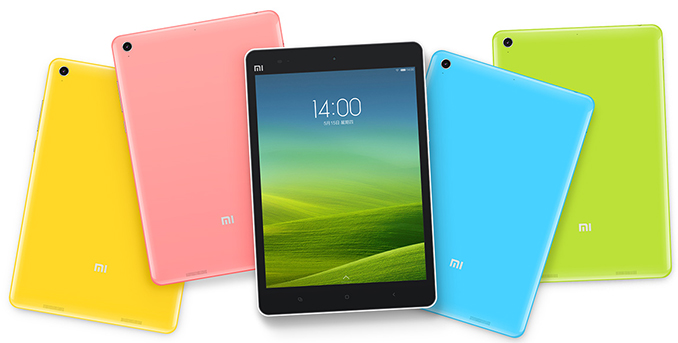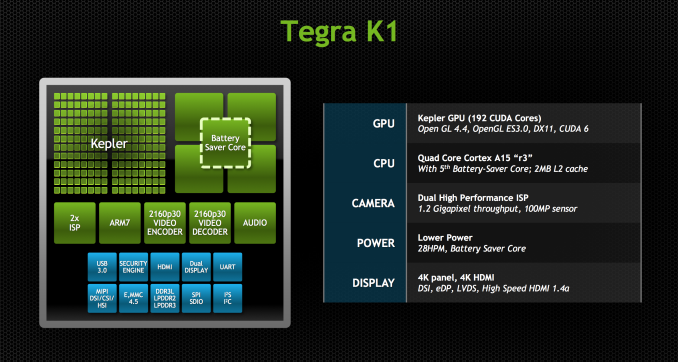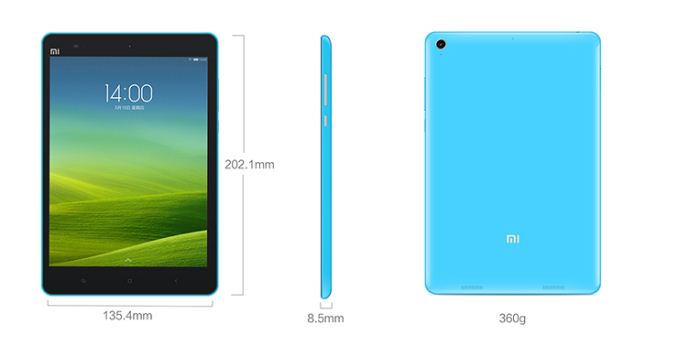Xiaomi Announces the MiPad: The First Tegra K1 Device
by Brandon Chester on May 15, 2014 9:40 AM EST
Today Xiaomi introduced its first tablet: the MiPad. The tablet bears similarity to both Apple’s iPad Mini and iPhone 5c. On the front of the tablet we have a 7.9” 2048x1536 IPS display (sourced from both Sharp and AUO Optronics) which is surrounded by an asymmetrical bezel. On the back we have a plastic shell of multiple different colors which Xiaomi itself states is made with the same injection molding technology as the iPhone 5c. There is also an 8MP Sony camera on the back with an F/2.0 aperture, and a 5MP camera on the front. The most interesting part of the Mi Pad is not on the outside, it's on the inside. The MiPad is the first consumer device to be announced that is powered by NVIDIA's Tegra K1 SoC.
As you may recall, NVIDIA introduced Tegra K1 to the world at CES 2014. It marks a huge departure from NVIDIA's mobile graphics strategy, abandoning the old Tegra GPU roadmap in favor of its desktop Kepler architecture.
Tegra K1 has two flavors, both built on a 28nm HPm process. One uses NVIDIA's Project Denver which will include two custom ARMv8 cores designed by NVIDIA. Denver is not slated to ship until later this year and so what we see in the MiPad is the other flavor of Tegra K1 which is a quad core ARM Cortex A15 design. Similar to other recent Tegra SoCs, this version of the K1 features four Cortex A15s plus an additional companion Cortex A15 optimized for lower frequencies for periods of low CPU usage. The CPU cores are based on a newer revision of Cortex A15 (r3p3) which includes finer grain power gating to reduce power consumption compared to revision r2p1 in the Tegra 4. This increase in efficiency will help balance out NVIDIA's move from a 1.9GHz max clock speed on Tegra 4 to over 2GHz on Tegra K1 (the move to 28nm HPm should help as well). The Tegra K1 SoC in the MiPad will ship with a max clock speed of 2.2GHz and 2GB of LPDDR3 RAM.
The GPU on Tegra K1 is something completely different from previous Tegra designs. Previous Tegra chips integrated NVIDIA's GeForce ULP core designed exclusively for its mobile platforms. With Tegra K1 Nvidia abandoned the idea of having a separate mobile roadmap for GPU designs and has merged its mobile and PC GPU roadmaps. The result is that Tegra K1 and all subsequent designs will ship with GPUs using the same architecture as NVIDIA's PC parts. With Tegra K1 we get a complete implementation of NVIDIA's Kepler architecture with 192 CUDA cores, 4 ROPs, and 8 texture units. It also brings along OpenGL ES 3.0, OpenGL 4.4, DirectX 11, CUDA 6.0, and every other API that Kepler supports.
NVIDIA has also shown a commitment to releasing software that will take advantage of their mobile GPUs. The company recently worked with Valve to bring Half Life 2 and Portal over to the NVIDIA Shield which is powered by a Tegra 4 CPU and I am sure that crafty users will bring the apps over to Tegra K1 devices if NVIDIA does not do so itself.
Beyond the SoC, the other internal specs for the MiPad include a 25.46 Whr (6700mAh) battery, 16 or 64GB of internal NAND, and a MicroSD slot. Connectivity includes support for 802.11 b/g/n/ac and Bluetooth 4.0. As with other Xiaomi devices, the MiPad runs Android with the MIUI UI atop it. It will launch in China sometime in June priced at 1499 yuan ($240) for the 16GB model and 1699 yuan ($272) for the 64GB model.












82 Comments
View All Comments
michael2k - Thursday, May 15, 2014 - link
It is! The only real question is that when it hits the market in June, it will be competing against the almost year old A7, and thus really it's competition won't be the year old iPad mini but the upcoming A8 iPad mini.In other words, the A7 iPad mini will likely drop in price to $299, which is much more competitive with the $240 MiPad, while the much more powerful A8 iPad mini will likely slot in at $399 and possibly be significantly faster.
Morawka - Thursday, May 15, 2014 - link
theres no way apple will sell the ipad mini with A7 at $299. They might go down $50, or they will do away with the aluminum unibody and go polycarbonite plastic like the iphone 5C. Apple is not in the habbit of dropping the price of their tablets that much. The 1st gen ipad mini only got a $50 reduction when the retina mini was released.@nathanddrews Apple has also bee making computers and devices for 20+ years. and when they designed the A7, its not like they were starting from step 1. They bought cpu design firms that had decades of experience. It's still impressive, but your comment makes it sound like apple designed this a7 with virtually 1-2 years of experience, when that is not true.
I really hope this device makes it to the US market soon, because nobody else has a retina like tablet on the market or even coming soon, with this kind of gpu in it.
nathanddrews - Thursday, May 15, 2014 - link
NVIDIA has specialized in only graphics for 20 years while Apple has had its hands in many different technologies. Apple has been learning GPUs quickly, but I would still completely expect K1 to decimate A7, and while a 2X fps advantage sounds great on paper, in reality it's a 2X fps advantage in one benchmark against a one year old chip with no knowledge of battery life/power usage. Don't get me wrong, both totally kick the crap out of my current tablet and I'd be happy to have either, but that's not the point.I need more data about K1 before I wet my pants over this, that's all.
Bob Todd - Thursday, May 15, 2014 - link
The GPU in the A7 isn't Apple's design anyway so the comparison here doesn't make much sense. The comparison would be between Nvidia and Imagination Technologies, which has been focused on mobile GPUs for quite a while.Spunjji - Friday, May 16, 2014 - link
A 2x FPS increase on the same process in the same form factor is massive. Huge deal. You're downplaying something that doesn't really need to be downplayed.michael2k - Thursday, May 15, 2014 - link
They've been dropping the price of their iPads every year since 2010. The issue is really by how much. So far they've set the floor at $299 for an almost 2 year old iPad mini or $399 for the 2 year old iPad with Retina.So the question is if they release a non Retina iPad with A7 to displace the iPad mini at $299, keep the iPad mini unchanged at $299, or move the iPad mini with A7 to the $299 pricepoint (or possibly $329, $349, whatever), and utilizing a plastic chassis to increase the profit margin.
They might do all of those things; leave the iPad mini unchanged except for switching to a plastic enclosure and selling at the $299 pricepoint, as an example.
Senor Mysterioso - Sunday, May 18, 2014 - link
Its not that competitive actually. Even if it drops to $299, Apple still blatantly gouges their customers on memory upgrades. A 64 gb iPad will be almost double the price of a 64gb mipad. Its disgusting that after so many years apple still charges 200 bucks more for a 64gb version when memory prices have fallen so much in that time. Xiaomi only charges 32 bucks more for the same upgrade. I would grab the 64gb MiPad in a heartbeat if it was available here.Yojimbo - Thursday, May 15, 2014 - link
You're leaving information out. "Outperform" does not do it justice. Granted it's their own chosen benchmark, but it's more than double. Semiconductor performance does not, in general, double in a year.alexvoda - Thursday, May 15, 2014 - link
I wish someone would invest in SED/FED technology again and bring it to market.SED/FED screens would be the best of most worlds combining advantages of CRTs, LCDs and Plasmas.
Meanwhile Sony gave up on OLED screens.
Will we really be stuck with LCDs???
Penti - Thursday, May 15, 2014 - link
Sony doesn't have any screen manufacturing at all, they sold Sony Mobile Display to JDI and their large panel-plant they partnered with (S-LCD) and closed that transaction in early 2012. So they can't really invest in any R&D if they don't intend to run any manufacturing plants. JDI does some OLED though. Sony basically gave up on everything there so they have to source from the open market as most.